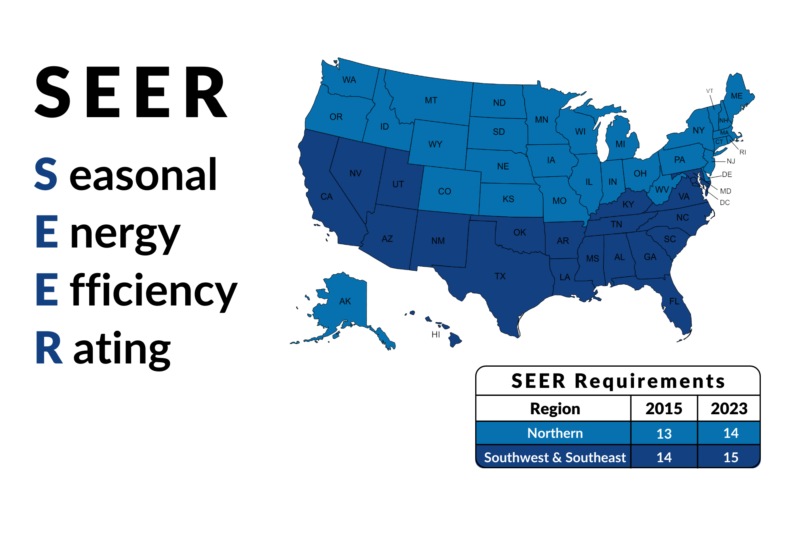
It is hard to think of an industry that does more to improve our quality of life than the HVAC contractor industry. In the United States alone, the heating and air conditioning contractor industry brings in more than $123 billion of revenue every year.
It takes more than 123,000 businesses around the country to make sure that everyone has access to quality HVAC contractors.
At the same time, the HVAC industry evolves decade by decade. New technological advances allow us to improve our insulation and other HVAC tools. As we become more capable of becoming energy efficient, regulations update to require us as a society to do so.
In the long run, these updates mean that our country becomes more energy efficient and provides a higher standard of living for as many people as possible. At the same time, most people do not find HVAC regulation updates to be fascinating.
It is still worth taking some time to familiarize yourself with these new standards. Read on to learn all about the most important things to understand about the latest updates to HVAC regulations!
Old Heating and Cooling Standards
Our institutions use measurements like the SEER rating to keep track of the kind of energy efficiency we are achieving. A few decades ago, old HVAC systems might have had a SEER rating that was as low as a five. In some cases, it might have even been lower.
In recent history, many HVAC regulations required cooling efficiency systems to achieve a SEER rating of 13 or 14, depending on the region. When it came to heating, all regions were required to achieve a heating efficiency of at least 14.
Back in 2015, the country was divided into three regions, so it made sense to give different energy efficiency standards. These three regions are the southeast region, the southwest region, and the north region. Hawaii falls under the category of the southeast region as far as HVAC regulations go.
But why would there be different HVAC energy efficiency standards for different regions of the country? The answer is that different sections of the country have different climates.
In places with hotter climates, people tend to use their air conditioning more. If you look at the required cooling efficiency in the southeast and southwest regions of the country in recent years, you will notice that these regions need to meet a somewhat higher efficiency standard for their cooling.
In the north, standards are somewhat lower. However, people use much less air conditioning in the north. Therefore, this does not lead to an excessive waste of energy.
However, do the new regional standards maintain this difference across regions?
Region Affects Your Cooling and Heating System Standards
In the northern region of the United States, HVAC efficiency standards will increase from 13 SEER to 14 SEER when it comes to air conditioning and other cooling systems. In other words, the northern region now has to meet the same energy efficiency standards that the southwest and southeast regions had to meet in the past.
However, the southwest and southeast regions cannot simply maintain their old levels of energy efficiency. According to new standards, they must raise their cooling system energy efficiency by a single SEER point as well.
In other words, the bottom line is that everyone needs to be a little more efficient when it comes to their cooling systems. However, there is still a difference in efficiency requirements between the northern region and the southeast and southwest regions.
Contact Us to Learn More About Your Region
Increases in Efficiency Ratings
It is important to keep in mind some of the finer points of the new HVAC regulations. When it comes to split units that use more than 45k BTU, the required energy efficiency is 14.5 SEER instead of the more standard 15 SEER in other cases.
On top of that, all regions of the country must reach a furnace rating of 81% AFUE.
Although we use SEER ratings to measure energy efficiency for cooling systems, we can use HSPF systems to measure heating efficiency.
When it comes to air-source heat pumps, the new standards require that we increase efficiency from 8.2 HSPF up to 8.8 HSPF at a minimum.
New HVAC Test Requirements
There are also new regulations regarding testing HVAC systems. In the past, efficiency measuring systems had the names SEER, HSPF, and EER. However, all three of these values will now have the number “2” added to the end of them.
In the past, HVAC contractors needed to measure the external static pressure on a unit from 1/10 of an inch of water. However, new tests must measure external static pressure when there is a full half-inch of water present.
Many people agree that this new testing system is much more realistic. It is not that common for people to deal with only 1/10th of an inch of water in such situations.
Learn More About the New Test Requirements
Why Change Efficiency and Maintenance Standards?
Our ability to be efficient with our energy depends on our technology. Our desire for energy efficiency depends, among other things, on whether or not we can afford to use up a lot of energy.
In recent years, our technology has advanced. That allows us to become more energy efficient if we want to do so.
Also, in recent years, our access to energy has become somewhat more limited. International events are making it harder to acquire energy from traditional sources.
As a result, we have more to gain from energy efficiency than we did in the past. Together, these dynamics help explain why increasing HVAC efficiency standards is a priority.
Understand the Most Important Things to Know About New HVAC Regulations
As the economy and technology evolve, so do HVAC regulations. It is important to familiarize yourself with new HVAC standards each time our institutions update them. Little by little, such increasing standards increase our quality of life as well as our efficient use of energy.
To learn more about new HVAC regulations and how to integrate them into your work, reach out and get in touch with us at any time!



